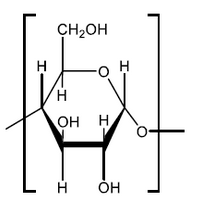Question
Starch is a natural polymer of glucose.
a. Draw the structure of the repeating unit of starch and state the type of linkage formed between these units.

Type of linkage:
b. Formulate the equation for the complete hydrolysis of a starch molecule, $\left(\mathrm{C}_6 \mathrm{H}_{10} \mathrm{O}_5\right)_n$.
c. Calculate the energy released, in $\mathrm{kJ} \mathrm{g}^{-1}$, when $3.49 \mathrm{~g}$ of starch are completely combusted in a calorimeter, increasing the temperature of $975 \mathrm{~g}$ of water from $21.0^{\circ} \mathrm{C}$ to $36.0^{\circ} \mathrm{C}$. Use section 1 of the data booklet.
d. Explain how the inclusion of starch in plastics makes them biodegradable.
▶️Answer/Explanation
Markscheme
a.
continuation bonds $A N D$-O- attached to just one end $\boldsymbol{A N D}$ both $\mathrm{H}$-atoms on end carbons must be on the same side [ $\boldsymbol{C}$ ]
Note: Square brackets not required.
Ignore ” $n$ ” if given.
Mark may be awarded if a polymer is shown but with the repeating unit clearly identified.
Type of linkage:
glycosidic [ $\checkmark]$
Note: Accept “ether”.
b. $\left(\mathrm{C}_6 \mathrm{H}_{10} \mathrm{O}_5\right)_n(\mathrm{~s})+n \mathrm{H}_2 \mathrm{O}(\mathrm{l}) \rightarrow n \mathrm{C}_6 \mathrm{H}_{12} \mathrm{O}_6(\mathrm{aq})[/]$
Note: Accept ” $(n-1) \mathrm{H}_2 \mathrm{O}$ “.
Do not award mark if ” $n$ ” not included.
c. $q=« m c \Delta T=975 \mathrm{~g} \times 4.18 \mathrm{~J} \mathrm{~g}^{-1} \mathrm{~K}^{-1} \times 15.0 \mathrm{~K}=» 61100 \ll \mathrm{J} » / 61.1$ «J»] [ «heat per gram $=\frac{61.1 \mathrm{~kJ}}{3.49 \mathrm{~g}}=» 17.5$ «J g g $^{-1} »[\boldsymbol{V}]$
Note: Award [2] for correct final answer.
d. Any two of:
carbohydrate grains swell/break plastic into smaller pieces $[\boldsymbol{V}]$
inclusion of carbohydrate makes the plastic more hydrophilic/water soluble $[\boldsymbol{V}]$
carbohydrates are broken down/hydrolysed/digested by bacteria/micro-organisms $[\boldsymbol{}]$
plastic becomes more accessible to bacteria as holes/channels are created in it $[\boldsymbol{V}]$
«presence of» carbohydrate weakens intermolecular/London/dispersion forces between polymer chains in the plastic [ $\boldsymbol{J}$ ]
Note: Accept “starch” for “carbohydrate” throughout. Do not accept carbohydrates are broken down/hydrolyzed.
Question
Proteins have structural or enzyme functions.
Oil spills are a major environmental problem.
a(i)Some proteins form an a-helix. State the name of another secondary protein structure.
a(ii) Compare and contrast the bonding responsible for the two secondary structures.
One similarity:
One difference:
b. Explain why an increase in temperature reduces the rate of an enzyme-catalyzed reaction.
c. State and explain how a competitive inhibitor affects the maximum rate, $\mathrm{V}_{\max }$, of an enzyme-catalyzed reaction.
d(i)Suggest two reasons why oil decomposes faster at the surface of the ocean than at greater depth.
d(ii)il spills can be treated with an enzyme mixture to speed up decomposition.
Outline one factor to be considered when assessing the greenness of an enzyme mixture.
▶️Answer/Explanation
Markscheme
a(i) $\beta /$ beta pleated/sheet $[\boldsymbol{V}]$
a(ii) One similarity:
hydrogen bonding
OR
attractions between $\mathrm{C}=\mathrm{O}$ and $\mathrm{N}-\mathrm{H}$ «on main chain» $[\boldsymbol{V}]$
One difference:
a-helix has hydrogen bonds between amino acid residues that are closer than $\beta$-pleated sheet
OR
H-bonds in a-helix parallel to helix axis AND perpendicular to sheet in $\beta$-pleated sheet OR
a-helix has one strand $A N D \beta$-pleated sheet has two «or more» strands
OR
a-helix is more elastic «since H-bonds can be broken easily» AND $\beta$-pleated sheet is less elastic «since H-bonds are difficult to break» [ $\boldsymbol{C}$ ]
Note: Accept a diagram which shows hydrogen bonding between $\mathrm{O}$ of $\mathrm{C}=\mathrm{O}$ and $\mathrm{H}$ of $\mathrm{NH}$ groups for $\mathrm{M1}$.
Accept “between carbonyl/amido/amide/carboxamide” but not “between amino/amine” for M1.
b. enzyme denatured/ loss of 3-D structure/conformational change
OR
«interactions responsible for» for tertiary/quaternary structures altered $[\boldsymbol{V}]$
shape of active site changes
OR
fewer substrate molecules fit into active sites [ $\boldsymbol{V}]$
c. $V_{\max }$ unchanged $[\boldsymbol{W}]$
at high substrate concentration substrate outcompetes inhibitor/need a higher substrate concentration to reach $\mathrm{V}_{\max }[\boldsymbol{V}]$
Note: Accept suitable labelled diagram.
d(i)Any two of:
surface water is warmer «so faster reaction rate»/more light/energy from the sun $[\boldsymbol{V}$ ]
more oxygen «for aerobic bacteria/oxidation of oil» $[\boldsymbol{\sim}]$
greater surface area $[\boldsymbol{\sim}]$
d(ii)Any one of:
non-hazardous/toxic to the environment/living organisms [ $\boldsymbol{U}]$
energy requirements «during production» $[\boldsymbol{\sim}]$
quantity/type of waste produced «during production»
OR
atom economy $[\boldsymbol{V}]$
safety of process $[\boldsymbol{V}]$
Note: Accept “use of solvents/toxic materials “during production»”.
Do not accept “more steps involved”.